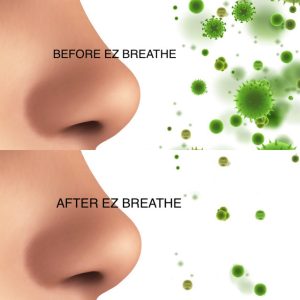In an era defined by the relentless pace of life, the importance of indoor air quality often escapes our conscious consideration. Yet, the air we breathe within the confines of our homes and workplaces is a silent yet powerful arbiter of our health problems and overall well-being. Indoor air quality (IAQ), a multifaceted concept, encompasses the intricate interplay of various factors that collectively influence the health and comfort of occupants.
As we navigate through the demands of our daily routines, it becomes imperative to pause and reflect on the significance of the air that envelops us indoors. Indoor air quality is not a mere technicality; it is a dynamic aspect of our environment that can significantly impact our physical health and mental resilience. The condition of the air we breathe indoors is a critical determinant of environmental health and the quality of life we experience within the walls of our homes.
Consider, for a moment, the diverse elements that contribute to the composition of indoor air. From the materials used in construction to the products we bring into our living spaces, each factor leaves an indelible mark on the air we inhale. Volatile organic compounds (VOCs), released from commonplace items like paints and cleaning agents, join forces with particulate matter, such as dust and pollen, to shape the complex tapestry of indoor air contaminants and pollutants. The intricate dance of humidity levels, ventilation, and the very architecture of our living spaces further influences the delicate equilibrium of indoor air quality.
Why does this matter? The consequences of neglecting indoor air quality are not merely theoretical but tangible and far-reaching. From the nagging discomfort of persistent headaches and fatigue to the more insidious threat of respiratory problems and allergies, poor indoor air quality casts a long shadow over our well-being. Long-term exposure to acceptable indoor air quality and pollutants has been linked to chronic health conditions, such as asthma and cardiovascular diseases, underscoring the urgency of addressing this often-overlooked facet of our living environment.
This article embarks on a comprehensive exploration of the intricacies surrounding indoor air quality, aiming to demystify the subject and empower readers with actionable insights. By delving into the common sources of indoor air pollutants, understanding the strategies to mitigate them helping reduce them, and recognizing the transformative benefits of breathing clean air, we endeavor to illuminate the path toward a healthier and more vibrant living space.
As we journey through the following sections, we will uncover practical strategies for improving indoor air quality—ranging from routine maintenance practices on windows and doors to conscious choices in building materials. Moreover, we will delve into the tangible advantages of investing time and effort into cultivating a healthier indoor environment, not just for ourselves but for the entire spectrum of occupants, from the youngest to the eldest.
In an era where well-being takes center stage, acknowledging the pivotal role that indoor air quality plays in our daily lives becomes paramount. The steps we take to improve indoor air quality and enhance IAQ are not merely technical measures; they are affirmations of our commitment to nurturing a living space that actively supports our physical and mental vitality. Join us on this journey as we explore the nuances of breathing easy and unlocking the potential for a healthier, more enriching life within the sanctuary of our homes.
The Significance of Indoor Air Quality:
The outdoor air pollution we breathe is a fundamental element of our existence, shaping not only our immediate comfort but also our long-term health. Indoor air quality (IAQ) emerges as a pivotal factor in this complex relationship, exerting a profound influence on the overall well-being of individuals within the shelter of their homes and workplaces.
At its core, IAQ refers to the condition of the air within buildings—a dynamic amalgamation of various elements that can either contribute to a healthy, invigorating atmosphere or serve as a breeding ground for discomfort and health issues. The significance of maintaining optimal indoor air quality becomes apparent when we consider the multifaceted nature of indoor air sources and their impact on human health and comfort.
- Health Implications: The human respiratory system is remarkably sensitive to the quality of the air it encounters. Poor indoor air quality, laden with pollutants and allergens, can manifest in a range of health issues. From the irritation of the eyes, nose, and throat to more severe respiratory conditions, the health implications are diverse and far-reaching. Long-term exposure to indoor pollutants has been associated with an increased risk of developing chronic respiratory diseases, making the link between IAQ and overall health particularly noteworthy.
- Comfort and Well-being: Beyond its direct impact on health, IAQ plays a crucial role in determining the overall comfort and well-being of occupants. Imagine a space where the air feels stale, laden with impurities—a scenario that can lead to persistent discomfort, headaches, and a pervasive sense of fatigue. In contrast, an environment with optimal IAQ fosters a sense of freshness and vitality, contributing to a more pleasant living and working experience.
- Productivity and Cognitive Function: The quality of the air we breathe has a direct bearing on cognitive function and productivity. Studies have shown that exposure to poor indoor air can lead to a decline in cognitive abilities, affecting concentration, decision-making, and overall mental acuity. Conversely, a well-ventilated and pollutant-free environment supports optimal cognitive function, creating an atmosphere conducive to productivity and creativity.
- Impact on Vulnerable Populations: Certain demographic groups, such as children, the elderly, and individuals with preexisting health conditions, are more susceptible to the effects of poor IAQ. Children, in particular, may experience developmental issues, while the elderly and those with compromised health may see exacerbations of existing conditions. Recognizing the impact on vulnerable populations underscores the societal importance of addressing and improving indoor air quality.
- Long-term Consequences: As our understanding of the long-term consequences of indoor air quality deepens, it becomes evident that investing in a healthy indoor environment is an investment in future well-being. The chronic conditions that can arise from prolonged exposure to indoor pollutants emphasize the importance of proactive measures to mitigate risks and create living spaces that promote longevity and resilience.
Common Indoor Air Pollutants:
The air within our homes, seemingly innocuous, can harbor a spectrum of pollutants that have far-reaching implications for our health. Understanding these common indoor air pollutants is crucial in developing effective strategies to combat their presence in homes and create a living space that nurtures rather than jeopardizes well-being.
- Volatile Organic Compounds (VOCs): Among the primary culprits compromising indoor air quality are volatile organic compounds or VOCs. These are gases emitted from a variety of household products, including paints, cleaning agents, adhesives, and certain furnishings. The “new car smell” or the scent of freshly painted walls is often a result of VOCs. Prolonged exposure to high levels of VOCs has been linked to respiratory irritation, headaches, and, in some cases, more severe health issues.
- Particulate Matter: Particulate matter encompasses tiny particles suspended in the air, including dust, pollen, pet dander, and microscopic pollutants. These particles, often invisible to the naked eye, can have significant health implications when inhaled. Allergies, respiratory irritation, and the exacerbation of preexisting conditions are common outcomes of exposure to elevated levels of particulate matter.
- Inadequate Ventilation and Carbon Dioxide: Insufficient ventilation leads to the accumulation of carbon dioxide (CO2) indoors. While CO2 itself is not inherently harmful at typical concentrations, elevated levels can lead to feelings of stuffiness and discomfort. More importantly, inadequate ventilation can hinder the removal of other pollutants from indoor spaces, compounding the overall impact on air quality.
- Biological Contaminants: Biological contaminants, including mold, bacteria, and viruses, thrive in environments with high humidity levels. Mold spores, in particular, can be a potent allergen and respiratory irritant. Effective control of humidity levels and regular maintenance are essential in preventing the growth and spread of biological contaminants.
- Tobacco Smoke: Smoking indoors introduces a powerful and harmful pollutant—tobacco smoke. Cigarette smoke contains a myriad of toxic chemicals, including formaldehyde and benzene, which can linger in indoor spaces long after smoking has ceased. The adverse health effects of exposure to secondhand smoke are well-documented, making it imperative to establish smoke-free indoor environments.
Recognizing these common indoor air pollutants is the first step toward creating a healthier living space. Each pollutant requires targeted strategies for mitigation, and a holistic approach involves addressing multiple sources of air pollution simultaneously. As we delve into the strategies for improving indoor air quality, it becomes clear that a comprehensive understanding of these pollutants is essential for fostering an environment that supports optimal health and well-being.
Strategies for Improving Indoor Air Quality:
- Regular Cleaning and Maintenance: Regular cleaning of floors, surfaces, and upholstery is essential to reduce the buildup of dust and allergens. Vacuum cleaners equipped with HEPA filters are particularly effective at trapping small particles.
- Proper Ventilation: Adequate ventilation is crucial for maintaining good IAQ. Opening windows and using exhaust fans in kitchens and bathrooms can help remove pollutants and bring in fresh air.
- Air Purifiers: Utilize air purifiers equipped with HEPA filters and activated carbon to effectively remove airborne particles and odors, enhancing overall air quality.
- Reducing VOC Emissions: When renovating or redecorating, choose low-VOC or VOC-free paints, adhesives, and building materials to minimize the emission of harmful chemicals.
- Indoor Plants: Certain indoor plants, such as snake plants and peace lilies, can naturally purify the air by absorbing pollutants and releasing oxygen.
- Maintaining Humidity Levels: Keep indoor humidity levels between 30% and 50% to prevent mold growth and dust mites, which thrive in more humid environments.
- Avoid Smoking Indoors: Tobacco smoke is a potent indoor air pollutant and should be strictly avoided indoors.
- Regular HVAC Maintenance: Heating, ventilation, and air conditioning (HVAC) systems should undergo regular inspection and maintenance to ensure efficient operation and prevent the spread of pollutants.
The Benefits of Good Indoor Air Quality:
Investing time and effort into cultivating good indoor and outdoor air quality, (IAQ) transcends the immediate comforts of a well-ventilated space. The transformative effects of breathing clean air extend into various facets of our lives, encompassing physical health, mental well-being, and overall quality of life. Here are the compelling benefits that underscore the significance of prioritizing and maintaining optimal IAQ.
- Improved Respiratory Health: Perhaps the most immediate and tangible benefit of good IAQ is the enhancement of respiratory health. Clean air, devoid of pollutants and irritants, promotes healthy lung function and reduces the risk of respiratory issues. Individuals with preexisting conditions such as asthma or allergies often experience fewer symptoms in environments with superior air quality.
- Reduced Allergies: Indoor air quality directly influences the prevalence and severity of allergies. By minimizing exposure to common indoor allergens such as dust mites, mold spores, and pet dander, individuals are less likely to experience allergic reactions. This reduction in allergic responses contributes to an overall sense of well-being.
- Fewer Headaches and Fatigue: Poor IAQ, often characterized by high concentrations of pollutants, can lead to persistent headaches and a pervasive sense of fatigue. Breathing in clean air free from harmful contaminants alleviates these symptoms, promoting a more comfortable and energized living environment.
- Enhanced Cognitive Function: The quality of the air we breathe has a direct impact on cognitive function. Good IAQ, achieved through proper ventilation and pollutant reduction, has been linked to improved concentration, heightened attention spans, and enhanced decision-making abilities. This is particularly crucial in work and educational settings where cognitive performance is paramount.
- Vital for Vulnerable Populations: Children, the elderly, and individuals with preexisting health conditions are particularly vulnerable to the effects of poor indoor air quality. Investing in good IAQ is a protective measure for these populations, ensuring a conducive environment for growth, development, and overall health.
- Long-Term Health Benefits: The long-term consequences of sustained exposure to indoor pollutants are a compelling reason to prioritize IAQ. By reducing the risk of chronic respiratory conditions, cardiovascular diseases, and other health issues linked to poor air quality, individuals contribute to their overall health and longevity.
As we prioritize our well-being, recognizing the pivotal role that indoor air quality plays in our daily lives is imperative. Simple practices like regular cleaning, proper ventilation, and conscious material choices can create a home environment that supports our physical and mental well-being. The air we breathe indoors should be as clean and refreshing as the fresh outdoor air we cherish.
For personalized solutions to indoor air quality problems and professional guidance on improving indoor air quality.
Contact the experts at EZ Breathe today at 330-468-6500. Breathe easy, and live healthy!







